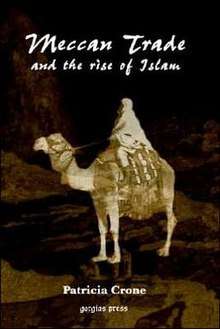Meccan Trade and the Rise of Islam
Meccan Trade And The Rise Of Islam is a book written by scholar and historiographer of early Islam Patricia Crone. The book argues that Islam did not originate in Mecca, located in western Saudi Arabia, but in northern Arabia.
 Cover | |
| Author | Patricia Crone |
|---|---|
| Language | English |
| Subject | Islam |
| Published | 1987 (Gorgias Press) |
| Media type | |
| ISBN | 1-59333-102-9 |
| OCLC | 57718221 |
Content
Crone found no evidence of Mecca being an important trading center in late antiquity of 6th and 7th century CE:
- Mecca was not on the overland trade route from Southern Arabia to Syria[1]
- Even if it had been, the overland trade route from Southern Arabia to Syria was not very important compared to the maritime trade route[1]
- by the end of the second century AD at latest, the route was no longer in use.[2]
- A close examination of the Muslim sources themselves show that, except for Yemeni perfume, the Meccans traded mainly in cheap leather goods and clothing, and occasionally, in basic foodstuffs (clarified butter and cheese)[3]
- These goods were not exported to Syria, which already had plenty of them, but were supplied almost exclusively to inhabitants of the Peninsula.[4]
If it is obvious that if the Meccans had been middlemen in a long-distance trade of the kind described in traditional Islamic literature, there ought to have been some mention of it in the writings of their customers who wrote extensively about the south Arabians who supplied them with aromatics. Despite the considerable attention paid to Arabian affairs there is no mention at all of Quraysh (the tribe of Mohammed) and their trading center Mecca, be it in the Greek, Latin, Syriac, Aramaic, Coptic, or other literature composed outside Arabia.[5]
She concludes that "Meccans did not trade outside of Mecca on the eve of Islam".[6] That there was no continuous transmission of historical fact through the three generations or so that separated the early first/seventh century from the mid-second/eight century" and that the lines of transmission of the accounts were "pure fabrications".[7]
Crone also found Islamic "traditions" to be unreliable, conflicting "with each other so often and so regularly `that one could were one so inclined, rewrite most of Montgomery Watt's biography of Muhammad in the reverse.'"[8]
An examination of all available evidence and sources leads Crone to conclude that Mohammed's career took place not in Mecca and Medina or in southwest Arabia at all, but in northwest Arabia.
Reception
Robert Bertram Serjeant, reviewing the book in the Journal of the American Oriental Society, described it as a "confused, irrational and illogical polemic, further complicated by her misunderstanding of Arabic texts, her lack of comprehension of the social structure of Arabia, and twisting of the clear sense of other writings, ancient and modern, to suit her contentions."[9]
Abdullah al-Andalusi of the Muslim Debate Initiative contended Crone's placing Islamic events not in Mecca, but closer to the Mediterranean, stating: "If there was a proto-Islamic sect pre-dating Meccan Islam existing at Abdad or elsewhere in Nabatean borderland between Arabia and the Roman Empire, an advanced and literate society with extensive trade links with the rest of the Roman world, it is surely utterly implausible that no sect, nor text of a sect, nor witness to the sect would have survived."[10]
Fred M. Donner, on the other hand, stated that "[the] assumption that Mecca was the linchpin of international luxury trade [has] been decisively challenged in recent years – notably in Patricia Crone, Meccan Trade and the Rise of Islam."[11], although Patricia Crone theory has been challenged by Robert Serjeant who favored the Meccan trade theory[12].
References
- Neva & Koren, "Methodological Approaches to Islamic Studies", 2000: p.431
- Crone, Patricia (1987). "2". Meccan Trade and the Rise of Islam. Princeton University Press.
- Crone, Patricia (1987). "4". Meccan Trade and the Rise of Islam. Princeton University Press.
- Crone, Patricia (1987). "5". Meccan Trade and the Rise of Islam. Princeton University Press.
- Patricia Crone, Meccan Trade and the Rise of Islam (Princeton, U.S.A: Princeton University Press, 1987), p.134
- Crone, Patricia (1987). Meccan Trade and the Rise of Islam. Princeton University Press. p. 114.
- Neva & Koren, "Methodological Approaches to Islamic Studies", 2000: p.432
- Crone, Patricia (1987). Meccan Trade and the Rise of Islam. Princeton University Press. p. 111.
- Serjeant, R. B.; Crone, Patricia (1990). "Meccan Trade and the Rise of Islam: Misconceptions and Flawed Polemics". Journal of the American Oriental Society. 110 (3): 472. doi:10.2307/603188. JSTOR 603188.
- Al Andalusi, Abdullah. "Tom Holland's Obsession with Islam's Origins: A Critical response". Muslim Debate Initiative. Retrieved 31 May 2017.
- Donner, Fred M. (2010). Muhammad and the Believers. Cambridge, Massachusetts: The Belknap Press of Harvard University Press. p. 241. ISBN 978-0-674-05097-6.
- D. Bukharin, Mikhail. "Mecca On The Caravan Routes In Pre-Islamic Antiquity". Brill. Retrieved 20 February 2020.
Bibliography
- Amaal Muhammad al-Roubi, A Response to Patricia Crone's Book (Meccan Trade and the Rise of Islam)
- Crone, Patricia (1987). Meccan Trade and the Rise of Islam (PDF). Princeton University Press.
- Nevo, Yehuda D.; Koren, Judith (2000). "Methodological Approaches to Islamic Studies". The Quest for the Historical Muhammad. New York: Prometheus Books. pp. 420–443.